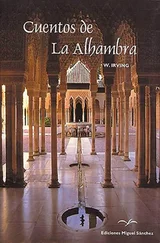Of this motley community, I find the family of my gossiping squire, Mateo Ximenes, to form, from their numbers at least, a very important part. His boast of being a son of the Alhambra, is not unfounded. His family has inhabited the fortress ever since the time of the conquest, handing down an hereditary poverty from father to son; not one of them having ever been known to be worth a maravedi. His father, by trade a ribbon-weaver, and who succeeded the historical tailor as the head of the family, is now near seventy years of age, and lives in a hovel of reeds and plaster, built by his own hands, just above the iron gate. The furniture consists of a crazy bed, a table, and two or three chairs; a wooden chest, containing, besides his scanty clothing, the “archives of the family.” These are nothing more nor less than the papers of various lawsuits sustained by different generations; by which it would seem that, with all their apparent carelessness and good humor, they are a litigious brood. Most of the suits have been brought against gossiping neighbors for questioning the purity of their blood, and denying their being Cristianos viejos, i. e. old Christians, without Jewish or Moorish taint. In fact, I doubt whether this jealousy about their blood has not kept them so poor in purse: spending all their earnings on escribanos and alguazils. The pride of the hovel is an escutcheon suspended against the wall, in which are emblazoned quarterings of the arms of the Marquis of Caiesedo, and of various other noble houses, with which this poverty-stricken brood claim affinity.
As to Mateo himself, who is now about thirty-five years of age, he has done his utmost to perpetuate his line and continue the poverty of the family, having a wife and a numerous progeny, who inhabit an almost dismantled hovel in the hamlet. How they manage to subsist, he only who sees into all mysteries can tell; the subsistence of a Spanish family of the kind, is always a riddle to me; yet they do subsist, and what is more, appear to enjoy their existence. The wife takes her holiday stroll on the Paseo of Granada, with a child in her arms and half a dozen at her heels; and the eldest daughter, now verging into womanhood, dresses her hair with flowers, and dances gayly to the castanets.
There are two classes of people to whom life seems one long holiday, the very rich, and the very poor; one because they need do nothing, the other because they have nothing to do; but there are none who understand the art of doing nothing and living upon nothing, better than the poor classes of Spain. Climate does one half, and temperament the rest. Give a Spaniard the shade in summer, and the sun in winter; a little bread, garlic, oil, and garbances, an old brown cloak and a guitar, and let the world roll on as it pleases. Talk of poverty! with him it has no disgrace. It sits upon him with a grandiose style, like his ragged cloak. He is a hidalgo, even when in rags.
The “sons of the Alhambra” are an eminent illustration of this practical philosophy. As the Moors imagined that the celestial paradise hung over this favored spot, so I am inclined at times to fancy, that a gleam of the golden age still lingers about this ragged community. They possess nothing, they do nothing, they care for nothing. Yet, though apparently idle all the week, they are as observant of all holy days and saints’ days as the most laborious artisan. They attend all fetes and dancings in Granada and its vicinity, light bonfires on the hills on St. John’s eve, and dance away the moonlight nights on the harvest-home of a small field within the precincts of the fortress, which yields a few bushels of wheat.
Before concluding these remarks, I must mention one of the amusements of the place which has particularly struck me. I had repeatedly observed a long lean fellow perched on the top of one of the towers, manoeuvring two or three fishing-rods, as though he were angling for the stars. I was for some time perplexed by the evolutions of this aerial fisherman, and my perplexity increased on observing others employed in like manner on different parts of the battlements and bastions; it was not until I consulted Mateo Ximenes, that I solved the mystery.
It seems that the pure and airy situation of this fortress has rendered it, like the castle of Macbeth, a prolific breeding-place for swallows and martlets, who sport about its towers in myriads, with the holiday glee of urchins just let loose from school. To entrap these birds in their giddy circlings, with hooks baited with flies, is one of the favorite amusements of the ragged “sons of the Alhambra,” who, with the good-for-nothing ingenuity of arrant idlers, have thus invented the art of angling in the sky.
Table of Contents
In one of my visits to the old Moorish chamber, where the good Tia Antonia cooks her dinner and receives her company, I observed a mysterious door in one corner, leading apparently into the ancient part of the edifice. My curiosity being aroused, I opened it, and found myself in a narrow, blind corridor, groping along which I came to the head of a dark winding staircase, leading down an angle of the Tower of Comares. Down this staircase I descended darkling, guiding myself by the wall until I came to a small door at the bottom, throwing which open, I was suddenly dazzled by emerging into the brilliant antechamber of the Hall of Ambassadors; with the fountain of the Court of the Alberca sparkling before me. The antechamber is separated from the court by an elegant gallery, supported by slender columns with spandrels of open work in the Morisco style. At each end of the antechamber are alcoves, and its ceiling is richly stuccoed and painted. Passing through a magnificent portal I found myself in the far-famed Hall of Ambassadors, the audience chamber of the Moslem monarchs. It is said to be thirty-seven feet square, and sixty feet high; occupies the whole interior of the Tower of Comares; and still bears the traces of past magnificence. The walls are beautifully stuccoed and decorated with Morisco fancifulness; the lofty ceiling was originally of the same favorite material, with the usual frostwork and pensile ornaments or stalactites; which, with the embellishments of vivid coloring and gilding, must have been gorgeous in the extreme. Unfortunately it gave way during an earthquake, and brought down with it an immense arch which traversed the hall. It was replaced by the present vault or dome of larch or cedar, with intersecting ribs, the whole curiously wrought and richly colored; still Oriental in its character, reminding one of “those ceilings of cedar and vermilion that we read of in the prophets and the Arabian Nights.” *
From the great height of the vault above the windows the upper part of the hall is almost lost in obscurity; yet there is a magnificence as well as solemnity in the gloom, as through it we have gleams of rich gilding and the brilliant tints of the Moorish pencil.
The royal throne was placed opposite the entrance in a recess, which still bears an inscription intimating that Yusef I (the monarch who completed the Alhambra) made this the throne of his empire. Every thing in this noble hall seems to have been calculated to surround the throne with impressive dignity and splendor; there was none of the elegant voluptuousness which reigns in other parts of the palace. The tower is of massive strength, domineering over the whole edifice and overhanging the steep hillside. On three sides of the Hall of Ambassadors are windows cut through the immense thickness of the walls, and commanding extensive prospects. The balcony of the central window especially looks down upon the verdant valley of the Darro, with its walks, its groves, and gardens. To the left it enjoys a distant prospect of the Vega, while directly in front rises the rival height of the Albaycin, with its medley of streets, and terraces, and gardens, and once crowned by a fortress that vied in power with the Alhambra. “Ill fated the man who lost all this!” exclaimed Charles V, as he looked forth from this window upon the enchanting scenery it commands.
Читать дальше












